A monthly e-newsletter from UMass Extension for landscapers, arborists, and other Green Industry professionals, including monthly tips for home gardeners.
To read individual sections of the message, click on the section headings below to expand the content:
UMass Extension's GREEN SCHOOL starts October 26!
When: Oct. 26 - Dec. 10, 2020, twice weekly
Where: Green School is going VIRTUAL! The COVID-19 pandemic has necessitated a temporary shift to remote delivery. Using available technology, we have attempted, to the extent possible, to recreate the traditional classroom Green School experience.
 Every two years, UMass Extension offers its popular Green School, a comprehensive 12-day certificate short course for Green Industry professionals taught by UMass Extension Specialists, University of Massachusetts faculty, and guest presenters. This course will not be offered again until 2022.
Every two years, UMass Extension offers its popular Green School, a comprehensive 12-day certificate short course for Green Industry professionals taught by UMass Extension Specialists, University of Massachusetts faculty, and guest presenters. This course will not be offered again until 2022.
Instruction in 2020 will be 100% virtual, providing attendees with online resources via an online learning management system, including a mixture of pre-recorded lectures, live lectures via Zoom and GoToWebinar, and live guided discussions/Q&A opportunities that compliment pre-recorded lecture material via Zoom.
THREE SPECIALTY TRACKS ARE OFFERED - Landscape Management, Turf Management, and Arboriculture
PRE-REGISTRATION IS REQUIRED, as space is limited! The early-bird rate ends Sept. 15.
Find the full schedule and registration info at: http://ag.umass.edu/greenschool
Hot Topics
Why Are Lawns Turning Black?
Much of New England experienced unusually hot, dry weather throughout the month of June. During this time, both irrigated and unirrigated turf stands endured abnormally severe heat and drought stress. Cool season grasses typically react to such conditions by going dormant, and thus some shoot dieback is likely to be observed. Many of us hoped to see the grass perk up a bit when needed rain finally arrived in early July, but what we saw instead was rapid decline and a sudden, distinctive blackening of the turf. What in the world is going on?
On closer laboratory inspection of multiple turf samples, abundant Curvularia was observed on dead shoot tissue. Curvularia is a ubiquitous and talented saprophyte, subsisting on dead plant material and remaining unnoticed most of the time. Like most other fungi, Curvularia also appreciates wet, humid weather, and is at its most active under such conditions.
So here is the scene: as heat and drought stressed turf dies back, Curvularia quietly moves into the dead blades. When the rain finally comes, the fungus is ready to take advantage of the situation and proliferates like crazy, quickly producing dark spores and spore-bearing conidiophores all over the place, which turns the grass black. The stressed turf is not able to respond to the rain as quickly, and initially it appears as if the turf has been killed by the fungus. Eventually, turf crowns that survived the environmental stress suffered in June will produce new growth, while any crowns that have died as a result of drought stress will not. In one case, after dead material had sloughed off, 75% of turf crowns produced new shoots when irrigated regularly.
It is important to note that other things will also cause turf to turn black, including Pythium blight and smut diseases (caused by pathogens such as Ustilago spp. and Urocystis spp). While both of these have also been observed at low levels in some areas, they do not appear to be involved in the more widespread incidents of blackening turf. In addition, there are numerous other species of dark saprophytic fungi that may also be involved in the black lawn phenomenon. These species may vary from location to location, but regardless of the species present, the etiology is the same.
Dr. Angela Madeiras, UMass Extension Plant Diagnostic Lab, and Dr. Nathaniel Mitkowski, University of Rhode Island
Questions & Answers
Q. What is causing this feeding damage on my oak’s leaves?
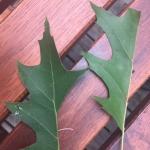 A. Feeding damage similar to what is shown on these oak leaves was recently reported by the University of New Hampshire Cooperative Extension Forestry and Wildlife Program. They report having received “several reports of defoliated branches, dropped leaves, and the sound of frass (caterpillar droppings) falling from tree canopies”. In New Hampshire, the culprit is reportedly the saddled prominent, or Heterocampa guttivitta. The saddled prominent (or maple prominent) is a native moth whose caterpillars feed on apple, beech, birch, blueberry, buckeye, chestnut, dogwood, hazel, hickory, hop hornbeam, maple (especially sugar maple), oak, persimmon, sour gum, sumac, walnut, and many other woody plants. The saddled prominent is known as “irruptive”, meaning that populations sometimes can build to where defoliation of large forest tracks in northern New England and eastern Canada are possible. However, as a native species, the saddled prominent is normally controlled by native birds, mammals, and other insects including predators and parasitoids.
A. Feeding damage similar to what is shown on these oak leaves was recently reported by the University of New Hampshire Cooperative Extension Forestry and Wildlife Program. They report having received “several reports of defoliated branches, dropped leaves, and the sound of frass (caterpillar droppings) falling from tree canopies”. In New Hampshire, the culprit is reportedly the saddled prominent, or Heterocampa guttivitta. The saddled prominent (or maple prominent) is a native moth whose caterpillars feed on apple, beech, birch, blueberry, buckeye, chestnut, dogwood, hazel, hickory, hop hornbeam, maple (especially sugar maple), oak, persimmon, sour gum, sumac, walnut, and many other woody plants. The saddled prominent is known as “irruptive”, meaning that populations sometimes can build to where defoliation of large forest tracks in northern New England and eastern Canada are possible. However, as a native species, the saddled prominent is normally controlled by native birds, mammals, and other insects including predators and parasitoids.
In Massachusetts, the cause of this feeding damage has not yet been confirmed by viewing samples of insects caught in the act, however some photographs of prominent moth-like caterpillars were also provided with images of this feeding in Ashburnham, MA. While the photos were clear enough to determine that the culprit in Massachusetts is likely another prominent moth, it is not certain if the activity can be blamed on the saddled prominent, or (what I’m leaning toward), the variable oakleaf caterpillar or Lochmaeus manteo. This is another prominent-type caterpillar in a different, but related genus. The variable oakleaf caterpillar has (as its name would suggest) a coloration and pattern that is highly variable in individuals. These caterpillars are mostly pale lime or blue-green with a back marked with green or with white or brick red saddles. (However, this species is very similar in appearance to the double-lined prominent, Lochmaeus bilineata and may need to be reared to adulthood to distinguish the two.) The variable oakleaf caterpillar feeds on beech, chestnut, and oak (preferred) but has also been reported on basswood, birch, elm, hawthorn, maple, walnut, and other trees (yet some of these records may be referring to the closely-resembled double-lined prominent).
So while a definitive identification of the culprit in this case has not yet been made, it would appear that native prominent moth caterpillars are having a good year in Massachusetts in 2020 as well as New Hampshire, and perhaps other parts of New England!
Q. I have two magnolia trees that have these all over them. Can you tell me what this is?
A. The insects pictured here are either one of the following: the magnolia scale or the tuliptree scale. The soft scale insects known as the magnolia scale (Neolecanium cornuparvum) and the tuliptree scale (Toumeyella liriodendri) can be difficult to differentiate in the field, depending upon the host they are found on. (On magnolia, it is very difficult to distinguish between the two species of soft scale.)
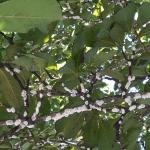
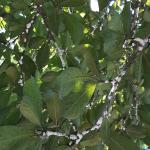 The magnolia scale is distributed throughout the eastern United States. The tuliptree scale is found east of the Mississippi River from Michigan to Alabama and from New York and Connecticut to Florida. It is also reported to be found in ornamental tuliptrees and magnolias in California and could be found wherever these trees are grown. Magnolia scale host plants include: Magnolia stellata (star magnolia), M. acuminata (cucumber magnolia), M. lilliflora ‘Nigra’ (lily Magnolia; formerly M. quinquepeta), and M. soulangeana (Chinese magnolia). Other species may be hosts for this scale, but attacked to a lesser degree. M. grandiflora (southern magnolia) may be such an example. Tuliptree scale host plants include: Liriodendron tulipifera (tuliptree or yellow poplar), Magnolia stellata (star magnolia), and M. soulangeana (Chinese magnolia). This insect has also been recorded on M. grandiflora (southern magnolia) and Tilia spp. (linden). The tuliptree scale has also, to a lesser extent, been reported on other ornamental trees and shrubs.
The magnolia scale is distributed throughout the eastern United States. The tuliptree scale is found east of the Mississippi River from Michigan to Alabama and from New York and Connecticut to Florida. It is also reported to be found in ornamental tuliptrees and magnolias in California and could be found wherever these trees are grown. Magnolia scale host plants include: Magnolia stellata (star magnolia), M. acuminata (cucumber magnolia), M. lilliflora ‘Nigra’ (lily Magnolia; formerly M. quinquepeta), and M. soulangeana (Chinese magnolia). Other species may be hosts for this scale, but attacked to a lesser degree. M. grandiflora (southern magnolia) may be such an example. Tuliptree scale host plants include: Liriodendron tulipifera (tuliptree or yellow poplar), Magnolia stellata (star magnolia), and M. soulangeana (Chinese magnolia). This insect has also been recorded on M. grandiflora (southern magnolia) and Tilia spp. (linden). The tuliptree scale has also, to a lesser extent, been reported on other ornamental trees and shrubs.
Mature individuals settle on a location on branches and twigs, then insert piercing-sucking mouthparts to feed. The insects feed on plant fluids and excrete large amounts of a sugary substance known as honeydew. Sooty mold, often black in color, will then grow on the honeydew that has coated branches and leaves. Repeated, heavy infestations can result in branch dieback and at times, death of the plant. Honeydew may also be very attractive to ants, wasps, and hornets. The life cycle of both of these species is similar and may have similar timing during the year, however subtle differences exist.
The life cycle of the magnolia scale is as follows: This scale overwinters as a young nymph (immature stage) which is elliptical in shape, mostly a dark-slate gray, except for a median ridge that is red/brown in color. These overwintering nymphs may be found on the undersides of 1st and 2nd year old twigs. The first molt (shedding of the exoskeleton to allow growth) can occur by late April or May in parts of this insect’s range and the second molt will occur in early June. At that time, the immature scales have turned a deep purple color. Stems of the host plant may appear purple in color and thickened – but this is a coating of nymphal magnolia scales, not the stem itself. Eventually, these immature scales secrete a white layer of wax over their bodies, looking as if they have been rolled in powdered sugar. By August, the adult female scale is fully developed, elliptical and convex in shape and ranging from a pinkish-orange to a dark brown color. Adult females may also be covered in a white, waxy coating. By that time, the females produce nymphs (living young; eggs are not “laid”) that wander the host before settling on the newest twigs to overwinter. In the Northeastern United States, this scale insect has a single generation per year.
The lifecycle of the tuliptree scale is as follows: The mature female tuliptree scale is hemispherical in shape. The color of the mature female varies in this species as well - a grayish-green to pink-orange insect mottled with black. Adult males emerge sometime in June and mate with the females. Like the magnolia scale, eggs develop within the body of the female tuliptree scale, leading to the “live birth” of immatures (crawlers) in late August and September. In the Northeast, one generation of tuliptree scales occurs per year. (However, in the southern-most portions of its range, this insect has been found in all stages of development during the winter, suggesting multiple generations per year.) A single female tuliptree scale may produce 3,000+ crawlers in one season. These crawlers are tiny (approximately the size of the head of a pin) and settle on host plant twigs in September. Past studies have shown that in addition to moving on their own with fully functional legs, the crawlers can be blown to new hosts on the wind, up to 100 feet away. (Being wind-blown to a new host, however, is a haphazard method of travel through which some less than 20% of these crawlers successfully make contact with a host plant, and fewer still attach to a suitable site on the plant.) The immature, crawler stage molts once prior to overwintering.
As two native scale insects in North America, the magnolia and tuliptree scales are hosts themselves for natural enemies that can impact their populations. Solitary parasitoid larvae have been collected from magnolia scales and have been identified as a syrphid fly species, Ocyptamus costatus. The natural enemies of the tuliptree scale have been studied to a greater degree and include certain lady beetle species [Hyperaspis signata, Adalia (formerly Hyperaspis) bipunctata, and Chilocorus stigma] which feed on nymphal scales, a number of parasitic wasps, and even an insect feeding moth caterpillar (Laetilia coccidivora). This particular moth species, also referred to as a type of snout moth, will consume the tuliptree scale underneath the protection of a silken web it spins over them! (The specific epithet coccidivora can be translated as “ones that eat soft scales” or Coccidae.) Unfortunately, in a landscape setting, it often seems that although these natural enemies may be common within the scale populations, they are seldom able to reduce the scale insect numbers below damaging levels. That being said, our management options should still seek to preserve these natural enemies.
Tawny Simisky, Extension Entomologist, UMass Extension Landscape, Nursery, & Urban Forestry Program
Trouble Maker of the Month
Summer Drought Stress on Turf
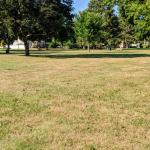 Here in New England, the summer is typically the most difficult environmental test for our favored cool-season grasses. The months of July and August historically have the lowest precipitation rates on average when compared across the calendar. Coupled with the fact that high summer soil temperatures result in inevitable root dieback, and hot and breezy conditions intensify moisture loss to the atmosphere via evapotranspiration (ET), the result is the perfect recipe for turf (and turf manager) stress.
Here in New England, the summer is typically the most difficult environmental test for our favored cool-season grasses. The months of July and August historically have the lowest precipitation rates on average when compared across the calendar. Coupled with the fact that high summer soil temperatures result in inevitable root dieback, and hot and breezy conditions intensify moisture loss to the atmosphere via evapotranspiration (ET), the result is the perfect recipe for turf (and turf manager) stress.
The general pattern to start the 2020 season was precipitation and temperature averages around normal for most of April and May, followed by a sudden arrival of both above normal temperatures and below normal precipitation that persisted throughout June. Although more consistent rainfall returned to some extent in many locations during the month of July, temperatures have stayed high. This has resulted in ongoing stress and prolonged turf dormancy on a lot of sites. Although we have reached that tentative point of the season where the finish line is in coming in to view, the race is not quite over yet.
Drought stress is a perennial challenge and looking below the surface into how turf is impacted by drought stress and the mechanisms by which turfgrass plants cope can improve management approaches and result in higher quality turf. The collective means by which plants deal with moisture stress is often termed drought resistance. Within drought resistance there are two principal, distinct components:
- Drought avoidance mechanisms promote the maintenance of a water status sufficient to prevent plant tissue injury, despite supply limitations. In other words, attempting to defer the effects of drought entirely. Avoidance centers on factors such as water absorption (rooting), and water loss (ET).
- Drought tolerance mechanisms promote the continuation of crucial biological processes, despite a plant water status inadequate for normal functioning and likely tissue injury. In other words, striving to endure the effects once drought sets in. Tolerance includes physiological responses such as increasing solute concentration to help conserve water within plant tissues.
A wide range of plant species use these mechanisms to varying degrees in response to reduced moisture levels. Avoidance mechanisms are most active during short-term water deficits, such as between irrigation events. Avoidance is a more important process for most turf managers, because avoidance supports the prevention of turgor loss and any associated tissue injury and performance reductions that follow. Maintenance of turf appearance and function is vital in systems for which performance is a primary consideration, such as golf and sports surfaces and high-value ornamental lawns.
Tolerance mechanisms are more about outright survival as opposed to performance preservation, thus tolerance becomes increasingly important as the duration and severity of drought progresses. A good understanding of tolerance mechanisms is especially useful for the management of lower maintenance systems such as roadsides, parks or cemeteries which are not irrigated and for which drought dormancy is commonly allowed in the summer.
The sensitivity and effectiveness of either avoidance or tolerance mechanisms can vary considerably based on many factors including turfgrass species and cultivars present, management practices, specific environmental conditions, etc. We certainly don’t have much control over temperatures or precipitation rates, but we can influence the drought resistance of a turf stand with approaches such as careful turfgrass selection and focused management. For example, turfgrass species and cultivars with propensity for deep and extensive root systems or leaf morphology that reduces ET loss will be better ‘avoiders’, while those with notable tendency for osmotic adjustment or synthesis of protective proteins will be better ‘tolerators’. Management practices that promote greater rooting and lower ET (regular mowing at an appropriate height, judicious fertility, etc) will encourage avoidance capability. Research has shown that deep, infrequent irrigation that allows for mild moisture stress between irrigation events enhances both rooting and the capacity for osmotic adjustment, leading to better drought resistance overall.
Summer moisture stress is a troublesome annual reality in the cool-season environment. Careful turfgrass selection and goal-oriented management with a mind to drought resistance, however, can promote water conservation, help in the maintenance of a desirable level of turf function and appearance, and enable better persistence of turf cover from season to season.
For more information on drought resistance, refer to our Turf Irrigation and Water Conservation fact sheet: https://ag.umass.edu/turf/fact-sheets/turf-irrigation-water-conservation
Summer stress often can lead to the need for late summer repairs and renovation, but planting time is right around the corner. For more information on selection of turfgrass species and cultivars for Massachusetts, including traits such as drought resistance, refer to the Turfgrass Selection: Species and Cultivars (https://ag.umass.edu/turf/professional-turf-ipm-guide/section-2-turfgrass-selection-species-cultivars) chapter of our Professional Guide for IPM in Turf (https://ag.umass.edu/turf/proguide).
Jason Lanier, UMass Extension Greenhouse Crops & Floriculture and Turf Specialist
Garden Clippings Tips of the Month
August is the time to:
- Keep deadheading annuals and perennials. Regularly deadheading can extend bloom, and prevent the plants from spending energy on seed production. Exceptions to this are the plants you want to gather seed from or allow to self sow. Verbena bonariensis, annual poppies, larkspur, amaranth, cosmos, foxgloves and other biennials fall into this category. If you have masses of these plants, it’s not necessary to let them all to go to seed, but rather it’s ok to let a few inconspicuous plants ripen seed and you can scatter them where you’d like. The remaining plants can continue to be deadheaded to encourage bloom or removed if bloom has finished and plants have declined.
- Don’t let up on weeding. Hopefully all of the work done so far this season has reduced the amount of weeds in the late summer garden and your plants have knitted in and are layered enough to reduce the space available for weeds. Keep an eye out for those hiding among the foliage of other plants, masquerading as ornamentals, and hiding at the back of the borders. Many are setting and ripening seed right now – get them before they spread. Don’t add those seeds to your useable compost but rather to a separate pile to decompose and not return to the garden. Keep an eye out for spots where organic mulches have decomposed and need refreshing.
- Remove diseased foliage from the garden. It should be disposed of in a way that prevents it from reinfecting the garden – either in the trash, buried onsite, or in a compost heap which in not used for garden beds and borders. Keep scouting for insects – a foray through the garden early in the morning with a cup of soapy water in hand often provides a chance to eliminate sluggish pests by knocking them into the soapy bath. Watch for squash bugs, remaining Japanese and Oriental beetles, tomato hornworms, Colorado and three-lined potato beetles, and spotted and striped cucumber beetles – check the UMass Extension factsheets for more details on these pests. Also, keep an eye out for those which are infected by parasitic organisms, like the white rice-shaped eggs of the parasitic fly on Japanese beetles and wasps on tomato hornworms – leave these individuals so that the parasites can continue to develop, reproduce and provide extended control.
- Continue to remove yellowed, diseased foliage. This is especially important for tomatoes but also beneficial for squash and cucumber, summer phlox, and peonies which are susceptible to powdery mildew. Additionally, peony foliage may succumb to a host specific botrytis fungi, Botrytis paeoniae, and should be removed and disposed of away from the garden. This disease usually manifests itself during wet humid conditions in spring and fall and can blacken new shoots, buds and young foliage earlier the season. Black spots and gray mold on stems and leaves appearing now should be pruned out and destroyed. In general, perennials with declining foliage – either flopping, insect ridden, succumbing to drought or heat stress, can be cut back now in order to keep the garden tidy and reduce disease and pest issues. Many will flush a fresh mass of leaves.
- Check container plants daily in August. Lush, full plantings that have filled the pot with roots and are overflowing with flowers and foliage might need water more than once a day and may need supplemental fertilizer, a topdressing with compost, or a soak with manure tea at this point in the season. Remember to water thoroughly, watching to see moisture seeping out of the bottom of the pot, to ensure that the entire root system has access to water. Plants stressed by lack of water and/or nutrients are more susceptible to insects and disease.
- Prepare for the fall planting season ahead. September and October are great months for planting – soil temperatures cool down, moisture is generally more plentiful, and there is plenty of time for root development before the ground freezes. Use the dog days of August to make your lists and seek out plants. This is also a good time to move and divide existing perennials, providing plenty of moisture as they settle back into the ground. Plants divided at this point should be cut back hard to reduce moisture loss.
- Place your bulb orders now in preparation for planting in October and November. Think about including deer, rabbit, squirrel and chipmunk resistant selections like Narcissus (daffodils), Fritillaria sp. (crown imperials, checker lilies), Scilla siberica (Siberian squill), Chionodoxa sp. (glory of the snow), Camassia (quamash). Don’t forget to order Colchicum sp. (fall crocus) early and plant in late August and early September, prior to blooming if possible.
- Keep watering efficiently as heat and drought persist. Most lawns and herbaceous borders need at least 1” of rain or supplemental irrigation a week to thrive. Supplemental water is best delivered in the early morning or early evening when it’s less likely to evaporate, and best delivered at the soil surface (soaker hoses, drip irrigation) when possible, rather than through the air (overhead sprinklers). Overhead sprinklers apply water to the leaf surface, which can reduce the amount reaching the root zone and contribute to foliar diseases by lengthening the period of time the leaves are wet. Water infrequently and deeply rather than a small amount daily. Watering restrictions, insufficient well capacity, and a desire to focus on environmentally responsible techniques have led many people to allow their lawns to slip into dormancy when dry conditions prevail. This strategy is particularly effective for lawns that have been otherwise well maintained, heathy and cut high. When cooler, moister conditions return, otherwise healthy lawns generally resume normal growth. Deep and thorough watering is also a key element in helping plants remain healthy enough to fend off insects and diseases.
-
Take some time step back and assess successes and failures. Make notes for the changes that will make this season - the height of the season – more manageable, fuller and more pleasing in 2021.
Joann Vieira, Director of Horticulture, The Trustees of Reservations
Scarab Pest in Landscapes
During the months of July and August, scarab beetles are commonly observed feeding on ornamental plants and/or flying to lights in the evening. Scarab beetles have robust oval bodies and club like antennae with plates at the ends. In landscapes, the most infamous members of this family are Japanese beetle, Oriental beetle, Asiatic garden beetle, and green June beetle. The first three species are invasive; the latter is native to North America. Larvae of these species are serious pests of turfgrass and can cause significant damage in lawns, athletic fields and golf courses. Adults of some species can be a problem for managed landscapes. For instance, adults of green June beetles feed on ripening fruit in June, causing significant damage, especially in grapes. Adults of Oriental beetles start flying in early July, peaking by mid-July, followed by Japanese beetles about a week later. Oriental beetles cause occasional damage to flowers, and especially prefer daisies, roses, hollyhocks, phlox, and petunias. Asiatic garden beetle adults fly in the early evening and are attracted to lights at night. Asiatic garden beetle adults feed on more than 100 species of ornamental plants and can also be important pests in agricultural species.
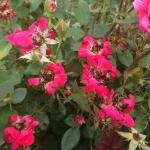 Among the above mentioned species, Japanese beetles are the most devastating species for ornamental plants. Japanese beetle adults can feed on more than 300 species of plants and cause severe defoliation. Adults feed on flowers or the tissues between the leaf veins, skeletonizing the leaves. Their feeding dramatically decreases the aesthetic value of the plant. For many years, it has been a dominant white grub pest in turfgrass. Most recently however, Oriental beetles have become a dominate species in New England. However, Japanese beetles remain the main concern for ornamental plants due to voracious feeding by adults.
Among the above mentioned species, Japanese beetles are the most devastating species for ornamental plants. Japanese beetle adults can feed on more than 300 species of plants and cause severe defoliation. Adults feed on flowers or the tissues between the leaf veins, skeletonizing the leaves. Their feeding dramatically decreases the aesthetic value of the plant. For many years, it has been a dominant white grub pest in turfgrass. Most recently however, Oriental beetles have become a dominate species in New England. However, Japanese beetles remain the main concern for ornamental plants due to voracious feeding by adults.
Chemical control targeting Japanese beetle adults is challenging and often not justified, having questionable results. Japanese beetle adult’s flight occurs when many ornamental plants are in full bloom, which attracts pollinators and natural enemies. The most commonly used Japanese beetle insecticides are contact, broad-spectrum materials with relatively short residuals (pyrethrins, carbamates, organophosphates). All of these insecticides are toxic to natural enemies and pollinators; therefore these products cannot be applied to flowering plants. Several Bt (Bacillus thuringiensis var. galleria) based insecticides (beetleJUS!TM and beetleGONETM) have narrower species-specific activity and are relatively non-toxic to bees. The main challenge of any chemical application is that it has to be applied several times because beetles feed for 6-8 weeks but the insecticides provide up to 3 weeks protection.
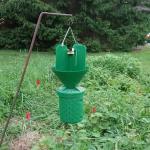 Several non-chemical options are available for Japanese beetle adult control. The mass trapping technique is commonly used in systems where conventional insecticides cannot be used to control pests. Japanese beetle traps were developed several decades ago. Sex pheromones and attractive plant volatiles are used as a lure which attracts both males and females. The scent used in the trap is a powerful attractant and can overcome the odor of the host plants. However, the efficiency of mass trapping for Japanese beetle management tool has been debated. The main concern is “trap overfill”, which happens when a trap attracts more beetles than it can catch. Either the trap gets overfilled and/ or beetles are attracted but land on nearby plants. Even though mass trapping of Japanese beetles might be effective in large scale orchard systems (Piñero and Dudenhoeffer, 2018), it may not be the best option in the landscape for small scale pest management (Potter and Held 2002, Switzer et al. 2009). It is, however, a great tool for monitoring to determine timing of management actions. If a trap is used on the property, it is recommended to install it at least 30 feet away from valuable plants.
Several non-chemical options are available for Japanese beetle adult control. The mass trapping technique is commonly used in systems where conventional insecticides cannot be used to control pests. Japanese beetle traps were developed several decades ago. Sex pheromones and attractive plant volatiles are used as a lure which attracts both males and females. The scent used in the trap is a powerful attractant and can overcome the odor of the host plants. However, the efficiency of mass trapping for Japanese beetle management tool has been debated. The main concern is “trap overfill”, which happens when a trap attracts more beetles than it can catch. Either the trap gets overfilled and/ or beetles are attracted but land on nearby plants. Even though mass trapping of Japanese beetles might be effective in large scale orchard systems (Piñero and Dudenhoeffer, 2018), it may not be the best option in the landscape for small scale pest management (Potter and Held 2002, Switzer et al. 2009). It is, however, a great tool for monitoring to determine timing of management actions. If a trap is used on the property, it is recommended to install it at least 30 feet away from valuable plants.
Hand picking of the beetles in the landscape is a feasible non-chemical control option that can significantly reduce beetle densities on ornamental plants (Switzer and Cumming 2014). Japanese beetles tend to aggregate on the host plant. If several beetles start feeding, the plant and beetles release volatiles which attract even more beetles. Although one beetle might not cause too much damage to the plant, this aggregated feeding is devastating to the ornamental plants. By handpicking the beetles from the plant, not only are the damaging insects removed, but the risk of attracting more beetles is reduced. The study conducted at Eastern Illinois University compared different timing of beetle handpicking: once a day and three times a day (8:00 AM, 2 PM and 7:00 PM) collections. The handpicking overall significantly reduced the number of beetles on the plant and, as a result, less plant damage was observed. The best collection time according to the study was 7:00 PM, which was similar in its efficacy to the three-times-per-day collection.
 Japanese beetle is an invasive species. When it was first introduced in 1916, there were no natural enemies in North America to keep the exploding populations at bay. Luckily, due to the extensive efforts of researchers, several biocontrol agents were identified and brought from its native habitat. One such enemy is a small tachinid fly, the winsome fly (Istocheta aldrichi), which was brought from South Korea and is now established in the Northeast. Female flies lay eggs on the pronotum of the beetles (Figure3), larvae hatch and feed inside the beetle body, killing the beetle in a couple of days. Interestingly, the flies usually lay eggs when the beetles are most vulnerable, during mating. Therefore, most of the affected beetles are females. During trapping or handpicking, the parasitized beetles can be easily detected and should be left in the area. Parasitized beetles usually die within a few days and are incapable of laying eggs, thus they do not pose any additional risk for ornamental plants or turf, but the parasitoid can survive and affect more beetles.
Japanese beetle is an invasive species. When it was first introduced in 1916, there were no natural enemies in North America to keep the exploding populations at bay. Luckily, due to the extensive efforts of researchers, several biocontrol agents were identified and brought from its native habitat. One such enemy is a small tachinid fly, the winsome fly (Istocheta aldrichi), which was brought from South Korea and is now established in the Northeast. Female flies lay eggs on the pronotum of the beetles (Figure3), larvae hatch and feed inside the beetle body, killing the beetle in a couple of days. Interestingly, the flies usually lay eggs when the beetles are most vulnerable, during mating. Therefore, most of the affected beetles are females. During trapping or handpicking, the parasitized beetles can be easily detected and should be left in the area. Parasitized beetles usually die within a few days and are incapable of laying eggs, thus they do not pose any additional risk for ornamental plants or turf, but the parasitoid can survive and affect more beetles.
References
- O’Hara J.E. (2014) New tachinid records for the United States and Canada. Tachinid Times 27: 34-40
- Piñero, J.C. and Dudenhoeffer, A.P. (2018) Mass trapping designs for organic control of the Japanese beetle, Popillia japonica (Coleoptera: Scarabaeidae). Pest. Manag. Sci, 74: 1687-1693. doi:10.1002/ps.4862
- Potter, D. A., and D. W. Held. (2002) Biology and management of the Japanese beetle. Annu. Rev. Entomol. 47: 175–205.
- Wawrzynski, R. P. & Ascerno, M. E. (1998). Mass trapping for Japanese beetle (Coleoptera: Scarabaeidae) suppression in isolated areas. Journal of Arboriculture, 24, 303-307.
- Switzer, P.V. & Cumming, R.M. (2014). Effectiveness of Hand Removal for Small-Scale Management of Japanese Beetles (Coleoptera: Scarabaeidae). Journal of Economic Entomology. 107. 293-8.
- Switzer P.V., Enstrom P.C., Schoenick C.A..(2009) Behavioral explanations underlying the lack of trap effectiveness for small-scale management of Japanese beetles (Coleoptera: Scarabaeidae). J Econ Entomol. 102(3):934-940. doi:10.1603/029.102.0311 0.1603/EC12303.
Olga Kostromytska, Extension Assistant Professor of Turf Entomology, UMass Amherst
Upcoming Events
For more details for any of these events, go to the UMass Extension Landscape, Nursery, and Urban Forestry Program Upcoming Events Page.
Tune in to a TickTalk with TickReport Webinars
This is a FREE live webinar series by Dr. Stephen Rich, Director of the UMass Laboratory of Medical Zoology held noon to 1:00 pm on the 2nd Wednesday of the month. Co-sponsored by UMass Extension and the UMass Laboratory of Medical Zoology. Register at https://ag.umass.edu/landscape/education-events/webinars
- Sept 9 - Biology of Ticks and Other Tick-Borne Disease
Speaker: Daniel Sonenshine, Professor Emeritus, Old Dominion University; Laboratory of Malaria and Vector Research, National Institute of Allergy and Infectious Disease (NIH)
Dr. Rich will host Dr. Daniel Sonenshine, preeminent tick biologist who quite literally wrote the book on ticks (Biology of Ticks in two volumes, co-authored with Dr. R. Michael Roe). Dr. Sonenshine’s research interest in ticks precedes the discovery of Lyme disease in North America and he is thus uniquely qualified to provide a historical context for this public health challenge. - Oct 14 - Tick-borne Disease Surveillance in the US
Speaker: Dr. Ben Beard, Deputy Director, Division of Vector-Borne Diseases, Centers for Disease Control and Prevention (CDC)
Dr. Rich welcomes Dr. Ben Beard to the TickTalk webinar. Dr. Beard will present the latest CDC findings on the burdens of tick-borne disease and public health trends. -
Nov 18 - Babesiosis
Speaker: Dr. Sam R. Telford III, Professor, Cummings School of Veterinary Medicine at Tufts University
Dr. Telford III joins Dr. Rich on the TickTalk webinar to discuss the second most commonly reported tick-borne disease in North America (after Lyme disease). Babesiosis is a malaria-like illness transmitted by the same ticks as Lyme. Dr. Telford is recognized as a global authority on this disease.
Green School
Classes will be held vitually 10/26 to 12/10. For more details and registration info, go to https://ag.umass.edu/landscape/education/umass-extensions-green-school.
- Sept 15 - Early-bird registration ends!
- Oct 15 - Deadline for receipt of applications.
Pesticide Exam Preparation and Recertification Courses
These workshops have been converted to a remote/online format. Contact Natalia Clifton at nclifton@umass.edu or go to https://www.umass.edu/pested for more info.
Invasive Insect Webinars
Find recordings of these webinars at https://ag.umass.edu/landscape/education-events/invasive-insect-webinars. Topics include the spotted lanternfly, spotted wing drosophila, brown marmorated stink bug, emerald ash borer, gypsy moth, winter moth, and Asian longhorned beetle.
InsectXaminer!
Episodes so far featuring gypsy moth, lily leaf beetle, euonymus caterpillar, and imported willow leaf beetle can be found at: https://ag.umass.edu/landscape/education-events/insectxaminer
Additional Resources
For detailed reports on growing conditions and pest activity – Check out the Landscape Message
For commercial growers of greenhouse crops and flowers - Check out the New England Greenhouse Update website
For professional turf managers - Check out our Turf Management Updates
For home gardeners and garden retailers - Check out our home lawn and garden resources. UMass Extension also has a Twitter feed that provides timely, daily gardening tips, sunrise and sunset times to home gardeners at twitter.com/UMassGardenClip
Food Gardening in Massachusetts 2020
With the uncertainties around the Coronavirus (COVID-19) and the economy, growing your own food is appealing as a way to help alleviate food insecurity, do something fun that is compatible with social distancing, and produce healthy and nutritious food! To become a successful gardener is not complicated; for the most part, the needed skills can be easily mastered. Join us for this series of weekly articles which with provide research-based information on how to grow your own vegetables and herbs in Massachusetts.
Some of the content has been adapted from the New England Vegetable Management Guide, a collaborative effort by members of the Extension Vegetable Programs of the New England states. These articles are written by Frank Mangan, Extension Professor of Vegetable Crops at the UMass Stockbridge School of Agriculture, and his Ph.D. student, Heriberto Godoy Hernandez, and are available in both English and Spanish. Additional expertise on specific topics is provided by UMass Extension Specialists.
Growing Your Own Food with Franco and Beto (Columna de Franco y Beto sobre el cultivo de sus propias hortalizas y hierbas aromáticas en Massachusetts) is available here: https://ag.umass.edu/resources/home-lawn-garden/food-gardening-in-massachusetts-2020
Diagnostic Services
Landscape and Turf Problem Diagnostics - The UMass Plant Diagnostic Lab is accepting plant disease, insect pest and invasive plant/weed samples (mail-in only - walk-in samples cannot be accepted). The lab serves commercial landscape contractors, turf managers, arborists, nurseries and other green industry professionals. It provides woody plant and turf disease analysis, woody plant and turf insect identification, turfgrass identification, weed identification, and offers a report of pest management strategies that are research based, economically sound and environmentally appropriate for the situation. Accurate diagnosis for a turf or landscape problem can often eliminate or reduce the need for pesticide use. Please refer to our website for instructions on sample submission and to access the submission form at https://ag.umass.edu/services/plant-diagnostics-laboratory. Mail delivery services and staffing have been altered due to the pandemic, so please allow for some additional time for samples to arrive at the lab and undergo the diagnostic process.
Soil and Plant Nutrient Testing - The UMass Soil and Plant Nutrient Testing Lab is accepting orders for routine soil analysis and particle size analysis ONLY (please do not send orders for other types of analyses at this time). Send orders via USPS, UPS, FedEx or other private carrier (hand delivered orders cannot be accepted at this time). Processing time may be longer than usual since the lab is operating with reduced staff and staggered shifts. The lab provides test results and recommendations that lead to the wise and economical use of soils and soil amendments. For updates and order forms, visit the UMass Soil and Plant Nutrient Testing Laboratory web site.
TickReport Update - The TickReport Risk Assessment & Passive Surveillance Program is open and tick samples can be submitted via https://www.tickreport.com. Please contact TickReport with with tick-related questions and updates on the status of their service.